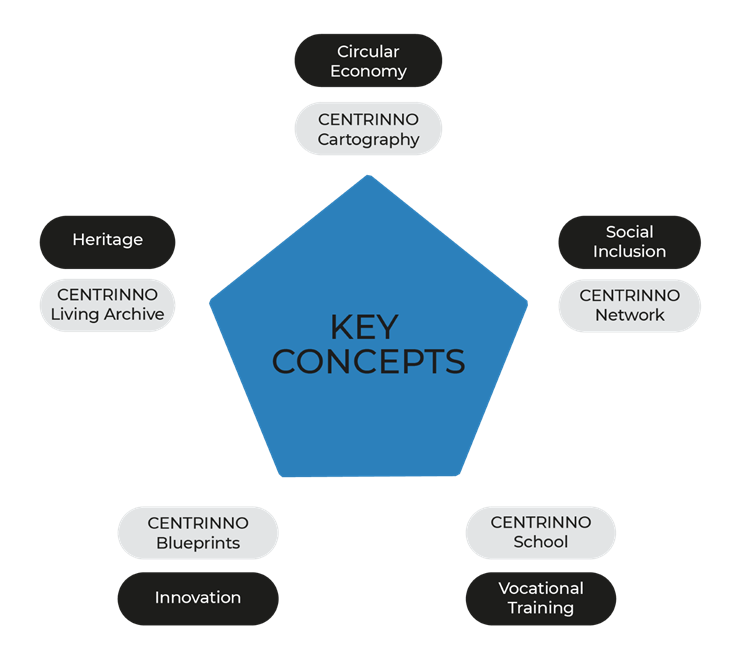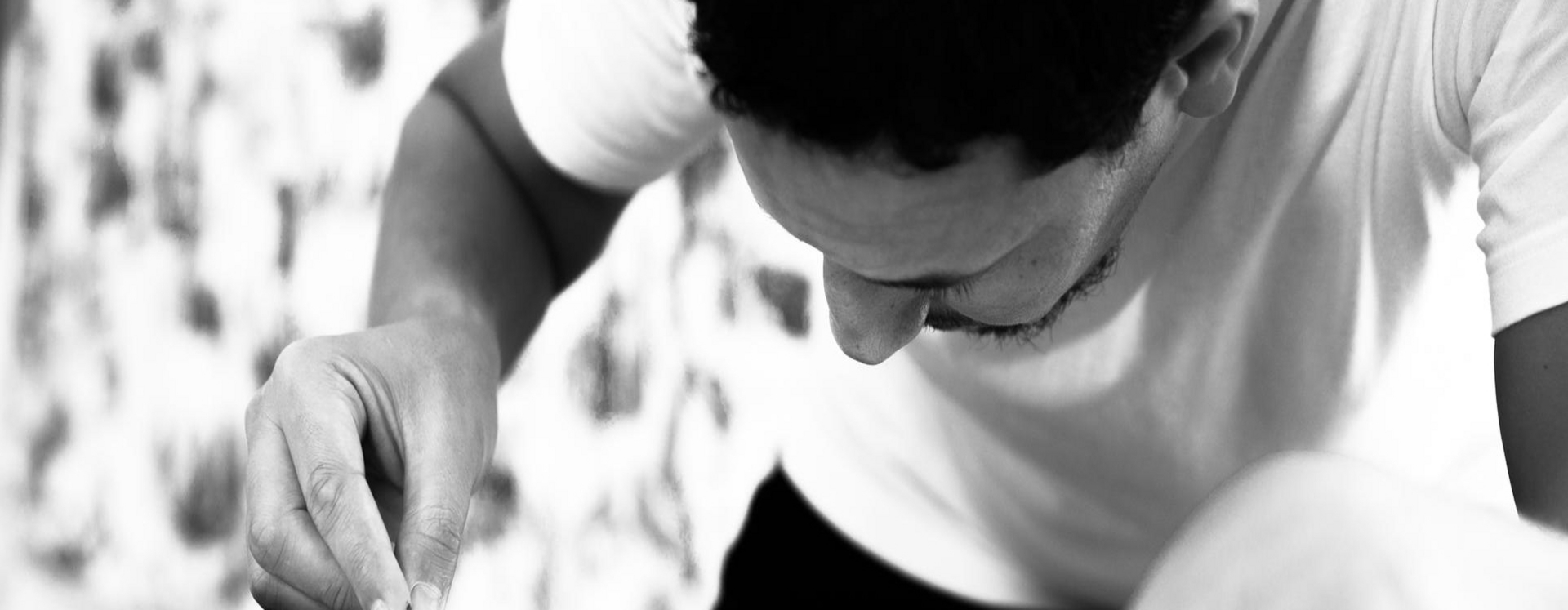CENTRINNO
Making heritage for an inclusive and circular future?
CENTRINNO: A European Project about:
Transition and the city
We need to make a transition towards circular societies across the globe. In the broadest sense, this is about how we deal with what comprises the physical environment. The urban environment in particular plays a role here, because more and more people are moving to live in cities. There is a lot to be gained when consumption behaviours change and people begin producing in more circular and efficient ways. It is therefore logical that the European Union has set as one of the major goals that cities must become circular and smart.
Making hubs
The EU sees part of the solution in supporting initiatives by groups of people working on new nodes (hubs) in the city where things, materials and resources are consciously brought together, and people try to work together in a circular way. People may share knowledge and skills, focus on recycling, design new and egalitarian - forms of management and governance, restore the place of nature in and with the environment, etc. Research on such initiatives is being carried out under the EU-funded HORIZON programme.
Fab City movement
Can we create a model for Europe? The Fab City movement thinks so. Together with leading institutions and networks of architects, designers, explorers and urban makers, the Fab City initiative has been awarded a major research request within the HORIZON programme. With a budget of 8.4 million euros, nine countries are working on such a model, especially for places where initiatives to develop circular hubs can already be seen. These are often former industrial sites, where space is often plentiful and the land is not that expensive. These places are central to why the EU has commissioned the wider project, which examines the specific role of such former industrial sites in the transition to a circular society.
Holistic approaches
In the development of the new model, CENTRINNO distinguishes five building blocks that - if smartly combined - should be able to help create lasting and increasingly influential, innovative, and inclusive circular hubs all over Europe. Since the start of the project in September 2020, these five blocks have been identified and specified. The exact interpretation, however, remains in flux, specific to the unique contexts of each site. The underpinning concepts, and the interplay between them, are indicated by the ‘spider web’:

- Innovation : A basic document (CENTRINNO Blueprints) with a description of the original ideas behind the FabCity movement and the accompanying toolkit to further develop a node or hub: the Innovation Spaces Toolkit .
- Circular Economy : A map (CENTRINNO Cartography) with examples of resources (raw materials, buildings, infrastructures, resources, contacts, etc.) that can be reused in and around the site and a toolkit to make such a map: the Urban Resources Mapping Toolkit, with background, instructions and models.
- Heritage: An archive (CENTRINNO Living Archive) containing examples of stories that are important in working on the inclusive circular hub. It involves specific, layered historical knowledge about the buildings, infrastructures, materials, people, practices and traditions, with a toolkit that can be used to create such an archive: the Emotion Networking Toolkit which also includes instructions for preparation (fieldwork, desk research) and elaboration (processing the 'found' emotion networks results into different type of stories).
- Vocational Education : Educational offer (CENTRINNO School) that can include (higher and secondary) vocational education in or linked to the circular transition in and around the hub, with attention to the hub as a network of people and things (materials and stories). This creates a network that you can become a part of, and that can help strengthen you, if you are familiar with and supportive of the ideas of systems and network thinking.
- Social Inclusion : A form of collaboration and knowledge sharing (CENTRINNO Network) characterized by inclusiveness, reciprocity and an iterative approach, with the Creative and Productive Hub Journal as a platform for the exchange of information about important meetings, events and new insights.
What does the Reinwardt Academy do in CENTRINNO?
Building a 'Living Archive'
This is a place (online platform and/or framework) where cities can host and display their archive material – not to languish there, but at least to live on for some time, serving as inspiration for others. Every city is asked to provide stories that can help develop the nodes into flywheels that help society in the transition. About twenty to thirty stories are supplied per city. These can also be sound, pictures, text, or other stories. They can be about:
- the location of 'the hub’ (e.g a story about De Ceuvel)
- buildings, parks, roads, (im)movable objects that are or were present on the site (e.g. a ship or crane)
- raw materials and materials that are or were present on the site (e.g. wood, rope, tar)
- working with these materials (e.g. woodworking, sawing, scaffolding, joining, gluing)
- events or phenomena that have taken place on the spot (e.g. strikes, graffiti)
Investigate the framework for action for heritage professionals in the transition to circularity
The Cultural Heritage research group wants to know what heritage professionals can contribute to the major issues of our time, and the question of how we can achieve a circular and environmentally-orientated society (read: engendering socio-economic and climate-based justice) is one of those big questions – perhaps the most important, it is here where all the other questions come together.
The professorship argues that heritage professionals (should) be experts in combining fieldwork, emotion networks and story curation with historical sensitivity, skill and curiosity. CENTRINNO offers us the opportunity to test this statement by contributing to the toolkits and supporting the various teams in retrieving diverse stories (about the rise of factories, social movements, impact on daily life, gender relations, de-industrialisation, ecological perspectives, environmental impact related to globalization, etc). Which stories will be able to inspire and accelerate the transition in and around the nodes or 'hubs'? Who is inspired by it, and why? Who is not, and why not? How does this work, and what is the role of heritage dynamics in this?
Designing and testing interventions with pilot cities
Under the motto 'practice what you preach', we think and participate actively as embedded researchers. Together with Imagine IC, we explore the layered effect of the past in the present in the pilot environments. Together with the partners, we investigate this layering using the method of emotion networks, to think alongside one another about strategies to retrieve stories that are relevant in a context of transition. This can emphatically also concern stories that have been forgotten, hushed up or repressed, but which do deserve attention. Gradually, we come to understand (the role of) heritage (professionals) within the context of the pilot teams and cities.
The actions we perform in this regard are:
- Orientation to historical context based on desk research into what is known and researched with regard to the location;
- Do ethnographic fieldwork on and around the hub location by being there, speaking to people, walking and observing. Together with the pilot teams, insight is gained into who is involved in the location (as stakeholders in a multi-directional list and network).
- Emotion Network sessions to gain insight with the team and stakeholders into the heritage dynamics regarding the chosen place and/or material and/or makership.
- Collecting stories and/or images from/during all the above activities and looking for forms to organize them in a living archive, including:
- A set-up on location (e.g. a wall with questions/information and participatory)
- An online or hybrid physical-online reference location, which is Interactive (e.g. in the format of a wall like Instagram, with possibility to share online to correlate with that format).
Develop knowledge on roles and perspectives
Phased in three sprint and delivery periods, our team is working on designing the Living Archive, and the Emotion Networking Toolkit.
During the work, we also try to map in a systematic way which factors and actors CENTRINNO teams relate to in their work. We wonder how a project like this, with the urgent objectives of realizing a circular and solidarity-based future in European cities, is part of gentrification and what that means… (Reinwardt, Erfgoedarena 2020).
When marking legacies from the past as 'heritage' (read: placing the past on a pedestal, revaluing it, etc.) a place inevitably changes. It may gain - figuratively and literally - a different value. Who or what benefits from this, and who or what is harmed by it ? And what remains behind, and why? For example, an old building is preserved, in a cleaner way, surrounded by inspiring stories. But whose is it? Who has a say in its ongoing presence?
Where are our own blind spots? That is why we investigate and involve with the pilot teams, using a polyphonic network approach, the process of heritage making, and the re-evaluation of traces from the past on and around the hubs, with:
- old and new people, for example::
- old and new residents and users of the place
- old and new companies
- passers-by
- project developers
- policy makers (municipal, national, EU)
- old and new materials, for example:
- wood
- iron
- plastic
- textiles
- (ground)water
- sand
- old and new buildings, goods, places, infrastructures, practices and traditions related to, for example:
- working
- living
- learning
- playing
- belonging
- food and drink
Researching competences
All our work is dominated by the search for actionable perspectives in contributing to the circular transition. In CENTRINNO the 9 pilot teams from different disciplines work together, but there are no heritage professionals in these teams. As researchers from the Reinwardt Academy, we wonder whether heritage professionals’ presence is necessary, and if so, from which approach? A combination of competencies is important:
- Knowledge (historical, current events, research/discourse, backgrounds of those involved)
- Skills (communication; non-violent, language, humor, research, active openness documentation; details, multisensory)
- Attitude (curious, empathy and empathy, interculturality, historically sensitive, cooperative,)
- Value (justice, peace, democracy/commons)
We will Investigate together how these competencies can be developed in CENTRINNO in a way that contributes to the transition to a circular society.
What will happen in the coming period?
After an exploratory period in which all pilot teams became acquainted with each other’s approach and methods, we are working intensively in 2021-2022 on:
- The testing of all actions to collect stories in the Amsterdam-pilot, and other pilots;
- Retrieving stories from these activities;
- Outlining and continuously discussing different models for the Living Archive framework with pilot teams;
Finally in 2021-2022, we focus on delivering the first (Alpha) version of the Living Archive, where we will be advised by various experts from various disciplines (such as architecture, urban planning, heritage democracy, commons, etc.). After this period, in 2022 and 2023, the pilots will engage in new sprints, and dive into new questions.
Want to know more?
Contact:
- Hester Dibbits, Lector Cultureel Erfgoed - hester.dibbits@ahk.nl
- Jonathan Even-Zohar, researcher and project manager CENTRINNO - jonathan.even-zohar@ahk.nl
- Harry Reddick, Junior researcher CENTRINNO - harry.reddick@ahk.nl
- Tessa Verloren van Themaat, Lectoraat support - tessa.verlorenvanthemaat@ahk.nl
Follow CENTRINNO on:
https://www.facebook.com/centrinnoeu/
https://twitter.com/centrinnoeu?lang=es
